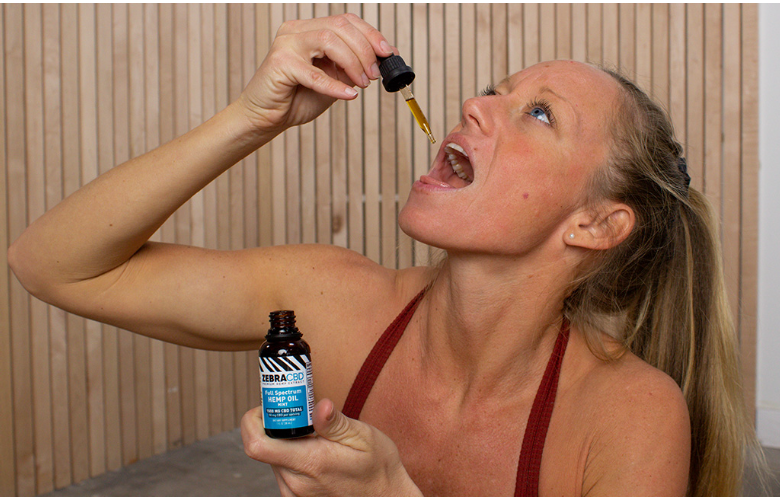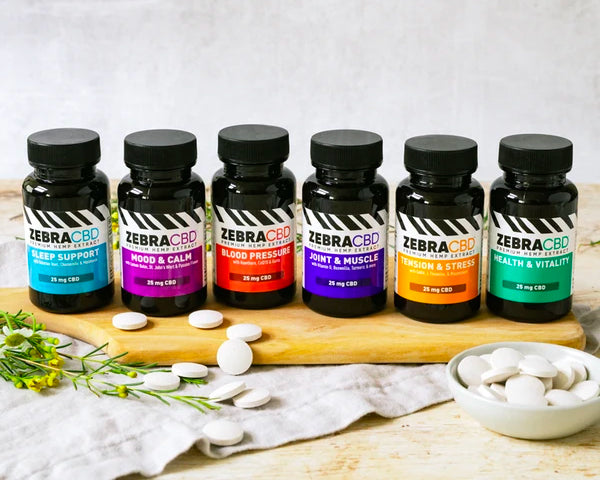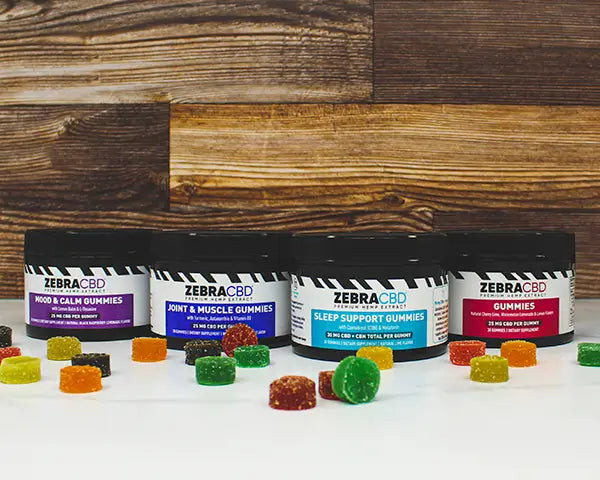
Headaches can greatly disrupt your daily life, especially if they’re particularly intense. The throbbing or pulsing tension can last for hours, and you may also experience accompanying symptoms, such as stomach discomfort, muscle stiffness or vomiting. In other cases, your symptoms may worsen if you’re exposed to bright lights or loud sounds.
While research is limited and inconclusive, CBD use may help relieve intense headache symptoms like these when applied topically. However, oral consumption may also be beneficial. In this guide, we’ll explore various types of headaches and how you might use CBD to alleviate your symptoms.
Understanding Headaches
We’ve all experienced a headache at one point or another. However, headaches can vary greatly in terms of intensity, symptoms, causes and even the area of the head affected.
Generally, speaking, there are two types of headaches that people can experience:
- Primary headaches– Primary headaches do not have exterior causes, such as a disease or physical impact. Rather, they’re disorders that must be diagnosed by a healthcare professional. That said, diagnosis is done clinically, meaning the healthcare provider will assess the symptoms, rather than conducting a blood test or imaging study. Primary headaches include tension headaches, hypnic headaches and cluster headaches, among other types of headaches. It’s important to note that certain primary headaches can be particularly intense, leading to symptoms such as vomiting.
- Secondary headaches – Secondary headaches are rare. They’re caused by an underlying condition, which manifests as neck or head discomfort. Possible causes include aneurysms, meningitis or physical injury.
Some primary headaches can be run-of-the-mill headaches, while others can be debilitating. People who are prone to debilitating primary headaches will often experience uncomfortable throbbing or pulsing on one side of the head. If they’re exposed to bright lights, strong smells or loud sounds, the discomfort can heighten. For that reason, it’s often advised for these people to seek a dark, isolated room if this type of headache develops.
Primary headaches affect millions of Americans and billions of people worldwide. According to researchers, some primary headaches may have a genetic component if they’re experienced consistently.
Despite this genetic aspect, the question still remains: what exactly triggers a primary headache? It’s not so certain. Some researchers believe that a type of neuroinflammation occurs from interactions between the nervous system, brain cells, blood vessels and systemic inflammation.
Another theory involves serotonin and estrogen, two hormones that may cause tension in the head or neck. More specifically, it’s believed that serotonin, which can create feelings of happiness, may excite the brain cells. As a result, blood vessels may narrow, causing an intense primary headache.
That said, fluctuating estrogen levels only affect women and people assigned female at birth (AFAB), since this chemical is a type of female sex hormone. As such, people AFAB may be more likely to experience these types of headaches. It’s believed that a sudden rise and fall of estrogen levels may also constrict blood vessels, causing throbbing in the head area. Low estrogen levels can also make nerves more sensitive to physical sensations and aches.
Beyond hormonal fluctuations, common primary headache triggers include:
- Stress or mood changes
- Exposure to bright lights or strong smells
- Fatigue or irregular sleep patterns
- Changes in the weather
- Some foods and drinks
Additionally, in some cases, auras can precede certain types of primary headaches. This means that people will begin to see dots or sparks, and they may also become dizzy and have trouble speaking.
Unfortunately, there are no cures for consistent and debilitating primary headaches. However, people who experience these types of headaches can make lifestyle changes to mitigate their impact. Oftentimes, people will implement medications and other therapies to reduce the discomfort of their headache symptoms.
The Brain on CBD
CBD, manufactured as a plant-based oil from the hemp plant, may be one such solution to headache management. Primarily, researchers have discovered that CBD has both antipsychotic and anxiolytic properties, meaning they’re most often used to manage mood changes and generalized nervousness, whether generalized or triggered by social situations.
That said, recent studies have also discovered that smoking medical cannabis, which contains CBD, may reduce the frequency of certain types of primary headaches, in addition to improving sleep. In fact, a 2019 study discovered that certain types of primary headaches were reduced by 49.6%, having more favorable results in women than men.
CBD use may also help manage the symptoms associated with intense primary headaches as well, such as stomach discomfort, since it interacts with serotonin receptors in the brain. In addition to its categorization as a hormone, serotonin is also recognized as a neurotransmitter. Our detailed article on CBD effects on hormones dives further into how this process works.
Neurotransmitters are chemical messengers that are critical to nearly all functions within the body. More specifically, they work within the nervous system to deliver messages from one nerve to the next to:
- Control muscle movements
- Facilitate healing
- Generate thoughts and feelings
- Enable learning and memory capabilities
- Sustain sleep cycles
- Promote digestion, hunger and thirst
- Create responses to the five senses
The neurotransmitter and hormone serotonin directly impacts mood, pleasure and sleep. Although, it’s also essential to the digestive system and healing process.
CBD attaches itself to a serotonin receptor, 5-HT1A, which controls:
- Mood
- Appetite
- Sleep
- Physical discomfort
- Stomach discomfort
Accordingly, it’s believed that CBD can positively impact these processes, providing headache relief as a result.
Recent studies have also found that CBD for headaches may have anti-inflammatory effects. That is, when ingested orally, it may help reduce neuroinflammation. When applied topically, it may help ease muscle and joint aches caused by intense primary headaches.
How to Use CBD For Headaches
CBD offers various administration methods, including oral consumption, topical application and inhalation through smoking or vaporization. However, it's crucial to emphasize that consulting with a healthcare professional is paramount to determine the most appropriate CBD dosage and method tailored to your medical needs.
When consuming CBD orally, there are various administration methods to choose from. These include:
- CBD oil and tinctures – CBD oil or tinctures are versatile and allow for precise dosing. They come with a dropper, enabling you to measure and control your CBD intake accurately. To use, simply place the desired amount of oil under your tongue and hold it there for about a minute before swallowing. This sublingual method allows for quicker absorption into the bloodstream.
- CBD capsules or softgels – CBD capsules and softgels provide a pre-measured dose of CBD, making it easy to track your intake and take the appropriate amount to relieve your symptoms.
- Edibles – CBD-infused edibles, such as CBD gummies, chocolates and beverages, are another option. These provide a tasty and enjoyable way to incorporate CBD into your routine. However, be cautious about the dosage, as the effects may take longer to kick in compared to other methods since they must first pass through the digestive system before entering your bloodstream to take effect.
For targeted relief of headache-related muscle tension and discomfort, CBD topical products can be highly effective:
- CBD creams and rubs – CBD-infused creams and rubs are designed for direct application to the skin. They can be massaged onto the temples, neck and other areas where you experience tension during an uncomfortable primary headache. The CBD in these products interacts with cannabinoid receptors in the skin and underlying tissues, offering localized relief.
- CBD roll-ons – Roll-on CBD products are convenient for on-the-go pain relief. They typically contain a blend of CBD oil, moisturizers and essential oils, such as avocado oil, cocoa seed butter, shea butter, eucalyptus oil, spearmint oil and peppermint oil. The cooling sensation from the roller can provide additional comfort when experiencing headache pain.
Inhalation of CBD through smoking or vaporization is another option for quick relief during a headache. However, this method may not be suitable for everyone, especially those with respiratory issues. It's crucial to use a high-quality CBD product specifically designed for inhalation to ensure safety and efficacy.
How to Choose High-Quality CBD For Headaches
When buying a CBD product that works for you, whether it’s a delicious edible or a convenient roll-on, it’s critical to ensure that the product comes with a Certificate of Analysis (COA), which can typically be found online.
The COA verifies that a third-party lab, separate from the distributor, tested the CBD for efficacy and safety. More specifically, the COA will identify:
- Details about the testing lab
- Ingredients list, which includes cannabinoids, terpenes and flavonoids
- Potency of each ingredient
The certificate also confirms that the product is free from harmful contaminants, such as heavy metals, pesticides, herbicides and molds.
If a COA is not available, it’s advised to not use the product, as it may contain harmful elements or significant levels of THC, the psychoactive compound found in cannabis plants.The types of CBD you choose may also impact its effectiveness when managing headaches.
Full-spectrum CBD contains all cannabinoids found in the cannabis plant, even THC, as well as flavonoids and terpenes. Although, THC levels won’t exceed 0.3%, meaning you won’t feel “high.” Rather, all the elements may work together to increase the effects of CBD. That said, if you’re looking to take CBD without the THC, you can incorporate broad-spectrum CBD into your management plan. Isolate CBD, on the other hand, is a pure form of CBD that does not contain other cannabinoids, flavonoids or terpenes.
Manage Your Headaches With Zebra CBD
While research is not conclusive, it’s theorized that CBD may help reduce inflammation and blood vessel constriction related to the development of primary headaches. It may also help mitigate symptoms related to certain types of headaches, such as stomach discomfort and vomiting.
For CBD you can trust, choose Zebra CBD. We provide a variety of CBD products made with premium hemp, which include CBD oils, CBD topicals, CBD chewable tablets, and CBD gummies for sale so that you can choose the right product that’s best for you.
Sources:
- Stanford Medicine. Type of Headache. https://stanfordhealthcare.org/medical-conditions/brain-and-nerves/headache/types.html
- Johns Hopkins Medicine. How a Migraine Happens. https://www.hopkinsmedicine.org/health/conditions-and-diseases/headache/how-a-migraine-happens.
- Cleveland Clinic. Neurotransmitters. https://my.clevelandclinic.org/health/articles/22513-neurotransmitters
- SW Londoner. CBD oil and relaxation: The impact of CBD on the serotonin system. https://www.swlondoner.co.uk/life/23042020-cbd-oil-and-relaxation-the-impact-of-cbd-on-the-serotonin-system









